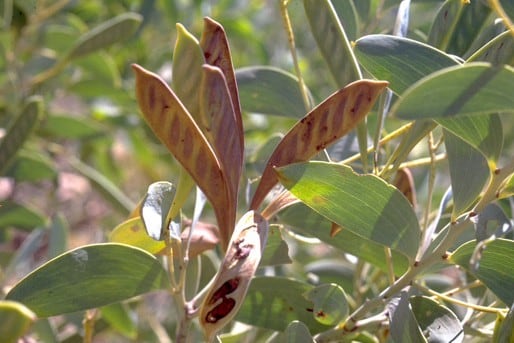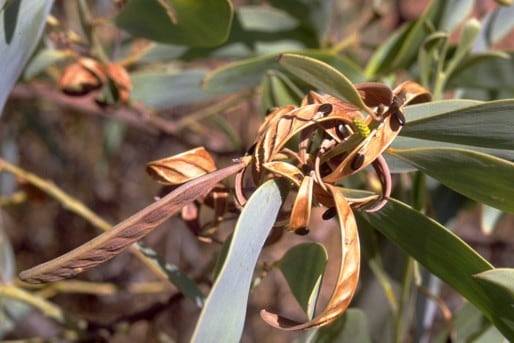Acacia limbata F.Muell.
WATTLE
Acacias of Australia
Family
Fabaceae
Distribution
Occurs in tropical Australia, from the Ord Region, W.A. to the McArthur R., N.T., and extreme north-western Qld.
Description
Shrub 0.4–2 m high, slender, glabrous, resinous. Bark longitudinally fissured, grey or greyish brown. Branchlets ±flattened towards apices, often pruinose, glabrous; ridges prominent, non-resinous. Phyllodes often continuous with branchlets, obliquely narrowly elliptic, elliptic-oblong or oblanceolate, often dimidiate, straight to subfalcate or rarely falcate, (5–) 6–10 (–12) cm long, 10–25 (–33) mm wide, with pale prominent margins, subcoriaceous, glabrous, with 3 prominent longitudinal nerves (2 continuous from base to apex, 1 confluent with lower margin near base) and 3 or 4 subprominent parallel nerves; minor nerves 2–3 (–4) per mm, anastomosing; gland 1, basal, 0.2–3.8 mm above pulvinus. Peduncles usually (15–) 20–40 (–50) mm long. Spikes 0.9–2.5 cm long, bright yellow. Flowers 5 merous; calyx 0.5–0.8 mm long, dissected for 1/3–1/2, glabrous; corolla 1.2–1.8 mm long, dissected for 1/3–1/2, glabrous; ovary glabrous. Pods erect, mostly narrowly oblanceolate, straight-sided, ±flat, 3.8–8.5 cm long, (8–) 10–15 mm wide, ±woody, reddish- or purplish-brown, paler over seeds, sometimes pruinose, obliquely nerved, glabrous, opening elastically from a hooked apex; seed partitions thick. Seeds oblique, elliptic to obovate, 4.6–6.6 mm long, brownish black; funicle-aril turbinate.
Phenology
Flowers Mar.–July.
Habitat
Grows on sandstone, in gravelly soils on stony hillsides, in open eucalypt woodland, usually near creeks, often with Melaleuca species.
Specimens
W.A.: Wade Ck, Osmond Ra., I.D.Cowie 1900 (BRI, CANB, DNA, K, MEL, NSW, PERTH); 44 miles [70 km] from Bedford Downs Stn towards Tablelands Stn, Kimberley, C.H.Gittins 1433 (NSW). N.T.: headwaters of McArthur R., S.T.Blake 17771 (BRI, NSW). Qld: Gregory–Lawn Hill road, C.H.Gittins 1266 (CANB, NSW); 27 km NW of ‘Corinda’, S.Jacobs 1511 (CANB, K, NSW).
Notes
Acacia limbata is allied to A. anastomosa, A. argyraea and A. lazaridis.
The description above excludes several similar specimens from Qld that differ from A. limbata, viz. Riversleigh Holding, C.H.Gittins 799 (NSW), Camooweal–Gregory road, c. 42 km beyond Thorntonia HS, C.H.Gittins 164 (NSW), and c. 3 km E of The Monument, P.L.Harris 628 (BRI). L.Pedley, Austrobaileya 1: 169 (1978), refers to a possible undescribed taxon, which these specimens may represent. They have larger phyllodes (9–12 cm long, 1.8–3 cm wide), a more prominent basal gland, longer pulvini (4–6 mm) and shorter peduncles (5–10 mm long). These specimens also have pubescent ovaries, glandular hairs on the calyx and longer pods (7–10 cm) than A. limbata. Further investigation is required.
FOA Reference
Data derived from Flora of Australia Volumes 11A (2001), 11B (2001) and 12 (1998), products of ABRS, ©Commonwealth of Australia
Author
Minor edits by B.R.Maslin & J.Rogers
Dr M.D.Tindale and Dr P.G.Kodela with the assistance of M.Bedward, S.J.Davies, C.Herscovitch, D.A.Keith and/or D.A.Morrison
This identification key and fact sheets are available as a mobile application:
URL: https://apps.lucidcentral.org/wattle/
© Copyright 2018. All rights reserved.










